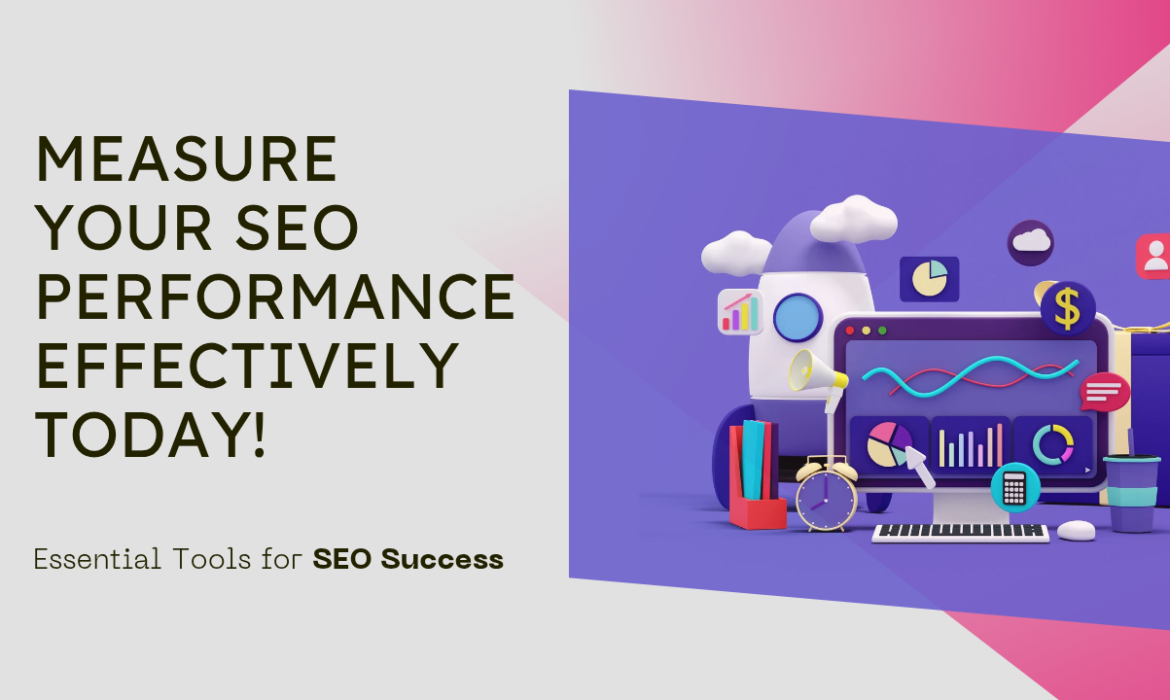081-4797-7173
Analytics is the backbone of successful digital marketing. It helps you understand what’s working and what isn’t. Whether it’s your SEO performances or social media campaigns, tracking performance is key to growth.
Why is this important? Because numbers don’t lie. They tell you where your audience is, how they behave, what they like and many more. With this information, you can customise your strategy for better results. But, the challenge is that many people don’t know how to use analytics effectively. They may have the tools but don’t understand the data. Or worse, they ignore it altogether.
This guide will show you the best tools to track your performances and visibility. In addition, we’ll share tips to make sense of the numbers.
Analytics Tools for SEO
SEO tools are vital for tracking website performance, diagnosing issues, as well as discovering new opportunities to grow your visibility.
Here are some of the most effective ones and how they can help you:
Google Analytics: A Traffic Tracker
Google Analytics is an essential tool for understanding how users interact with your website. It provides detailed information about your visitors, including where they come from, which pages they visit, and how long they stay.
By monitoring your traffic sources, you can see if users are finding you through organic searches, social media, or referral links. For example, if organic traffic is low, it might be time to review your SEO strategy and focus on optimising underperforming pages.
Google Search Console: Improving Search Visibility
Google Search Console offers valuable insights on how your website performs on search engines. It shows which keywords drive traffic to your site, how many impressions and clicks your pages receive, and any technical issues that could hurt your rankings.
By regularly reviewing the performance data, you can identify high-potential keywords and also focus on optimising content around them. The tool also flags problems like broken links or mobile usability issues, making it easier to fix these before they affect your rankings.
SEMrush and Ahrefs: Competitive Analysis and Keyword Discovery
For more advanced keyword analysis, SEMrush and Ahrefs are excellent choices. These tools go beyond basic metrics and help you understand your competition.
They allow you to track your competitors’ rankings, analyse their backlink profiles, and identify keyword opportunities you might have missed. For example, Ahrefs’ keyword gap analysis feature can highlight search terms that your competitors rank for but you don’t, giving you a roadmap to close those gaps.
Yoast SEO: Content Optimisation for WordPress
If you use WordPress, Yoast SEO is a must-have. It provides real-time feedback on your blog posts and web pages, helping you improve SEO and readability.
This plugin evaluates factors like keyword density, internal links, and sentence length, and it offers suggestions to refine your content. Striving for a green light on both SEO and readability ensures your posts are well-optimised for search engines while remaining user-friendly.
Analytics Tools for Social Media
Social media analytics tools are essential for understanding how your campaigns are performing and what resonates with your audience. They provide data-driven insights that help refine your strategy for better results. Below are some of the most effective tools for analysing social media performances:
Meta Business Suite: Managing Facebook and Instagram Analytics
Meta Business Suite is a powerful tool for businesses running Facebook and Instagram campaigns. It also offers insights into metrics like reach, impressions, and engagement. With this tool, you can track how well your posts and ads perform, monitorty audience demographics as well as schedule content. For example, analysing post engagement rates can help you identify the type of content your audience enjoys the most.
Hootsuite and Sprout Social: All-in-One Dashboards
For managing multiple social media platforms, Hootsuite and Sprout Social are excellent choices. These tools provide centralised dashboards where you can track engagement, monitor mentions, and measure overall performance across platforms like Twitter, LinkedIn, and Instagram. They also offer detailed reports that can guide decisions on when to post and which platforms need more attention.
Twitter Analytics: Insights for Real-Time Engagement
Twitter Analytics is an in-built tool that helps you track tweet impressions, engagement rates, and audience growth. It also breaks down how individual tweets perform, showing which ones drive the most interaction. By regularly reviewing these insights, you can determine the best times to post and the types of content.
LinkedIn Analytics: Understanding Professional Connections
For B2B marketers, LinkedIn Analytics is very essential. It provides data on post reach, profile views, and audience demographics, allowing you to tailor your content to a professional audience. If your goal is to attract decision-makers, LinkedIn Analytics can show you whether your posts are engaging the right people, such as those in senior roles or specific industries.
Tips for Analysing Social Media Performance
Knowing how to analyse your social media performance is just as important as the tools you use. It’s not just about collecting data, it’s also about interpreting it and taking action. Here are some practical tips to make sense of your social media metrics and optimise your strategy.
Focus on Key Metrics That Matter
Not all metrics are created equal. Vanity metrics like follower counts can be misleading if they don’t translate into meaningful engagement or conversions. Instead, focus on actionable metrics such as engagement rate, click-through rate (CTR), and conversion rate. For instance, if your CTR is low, it may be time to rework your call-to-action (CTA) or improve your ad campaigns.
Compare Performance Over Time
One post’s success might be an anomaly. To truly understand how your social media campaigns are performing, track metrics over time. Use tools like Hootsuite or Meta Business Suite to generate monthly reports. These reports help you spot trends, like which type of content performs best during specific times of the year, enabling you to plan more effectively.
Segment Your Audience Data
Your audience isn’t a monolith. By breaking down demographics such as age, location, and interests, you can create custom content for different segments. For example, Instagram insights may show that your younger audience prefers interactive stories, while older followers engage more with in-depth carousel posts. Catering to these preferences increases your chances of engagement.
Use A/B Testing to Optimise Content
Don’t rely on guesswork to determine what works best. Instead, use A/B testing to experiment with different headlines, visuals, and CTAs. Tools like Meta Business Suite make this easy by allowing you to test variations of your ads. If one version gets significantly more clicks, you’ll know what resonates with your audience.
Monitor Competitor Performance
Keeping an eye on your competitors can reveal gaps in your strategy. Tools like SEMrush and Sprout Social let you compare your performance with industry leaders. If a competitor’s posts are gaining more traction, analyse what they’re doing differently. Perhaps they post more often, use specific hashtags, or engage more with their audience.
Create Actionable Reports
Finally, all the data in the world won’t help if you don’t act on it. Compile regular reports that summarise your metrics and highlight areas for improvement. Use visualisations like graphs to make data easier to digest, and share these insights with your team. With a clear understanding of your performance, you can make data-driven decisions that lead to better results.
Tips for Analysing SEO Performance
SEO performance analysis is critical for improving your website’s visibility and attracting more organic traffic. By diving into the right metrics and using a strategic approach, you can ensure that your efforts yield meaningful results. Here are some key tips to get started.
Track Your Organic Traffic Regularly
Organic traffic is one of the most important indicators of SEO success. Tools like Google Analytics can help you monitor how many visitors land on your site through search engines. Check the organic traffic report to identify trends. If you notice a decline, it might be due to recent algorithm updates or reduced keyword relevance. Addressing these issues quickly can prevent further dips in performance.
Evaluate Your Keyword Rankings
Keywords remain at the heart of SEO. Use tools like SEMrush or Ahrefs to monitor your keyword rankings. Focus on high-value keywords that drive traffic to your site. For example, if your rankings for important keywords drop, it may signal a need to refresh your content or build additional backlinks. Regularly updating your keyword list ensures that your strategy stays relevant as search trends evolve.
Analyse Your Click-Through Rate (CTR)
Your CTR shows how well your website attracts clicks from search engine results pages (SERPs). If your CTR is low despite ranking high for certain keywords, it might be time to rewrite your meta titles and descriptions. Make them more engaging and actionable and also include numbers, questions, or power words can help entice users to click.
Check for Technical Issues
SEO isn’t just about content; technical performance matters too. Regularly audit your website for issues like slow page speeds, broken links, or poor mobile optimisation. Tools like Google Search Console and PageSpeed Insights can identify these problems. Addressing them not only improves user experience but also boosts your search engine rankings.
Pay Attention to Backlinks
Backlinks are a major factor in SEO, but not all links are created equal. Tools like Ahrefs can help you evaluate the quality and quantity of your backlinks. If you have links from low-authority or spammy websites, disavowing them is necessary to protect your site’s credibility. At the same time, focus on earning high-quality backlinks by creating valuable content that others will want to reference.
Monitor Bounce Rate and Dwell Time
Bounce rate and dwell time give insights into how engaging your content is. If users leave your site quickly, it’s a sign that your content might not meet their expectations. Look at the pages with the highest bounce rates and consider improving their layout, adding more relevant information, or using engaging visuals. On the other hand, high dwell time shows that visitors find your content valuable.
Create Monthly SEO Reports
Consistent reporting is essential for tracking progress. Summarise metrics like organic traffic, keyword rankings, and bounce rates in a report. Visual aids like charts and graphs can make the data more digestible. Finally share these reports with your team to highlight what’s working and identify areas needing attention.
Conclusion
In conclusion, effective analytics is the backbone of any successful digital marketing strategy. By using the right tools and applying strategic tips, you can uncover valuable insights about your audience, refine your approach, and stay ahead of the competition. Regularly monitoring your performance allows you to adapt quickly to changes and ensure that your strategy remains aligned with your goals.
So, start small, stay consistent, and let the data guide your decisions. Eventually you will see the impact of a data-driven approach on your business growth. Be sure to let us know in the comments your experience with analytics and leave any questions you may have.
0






